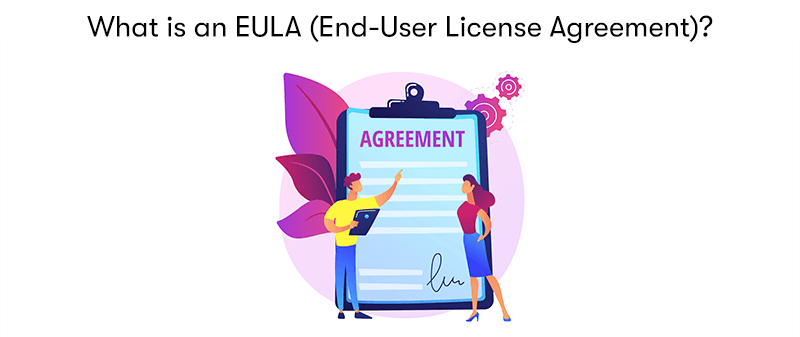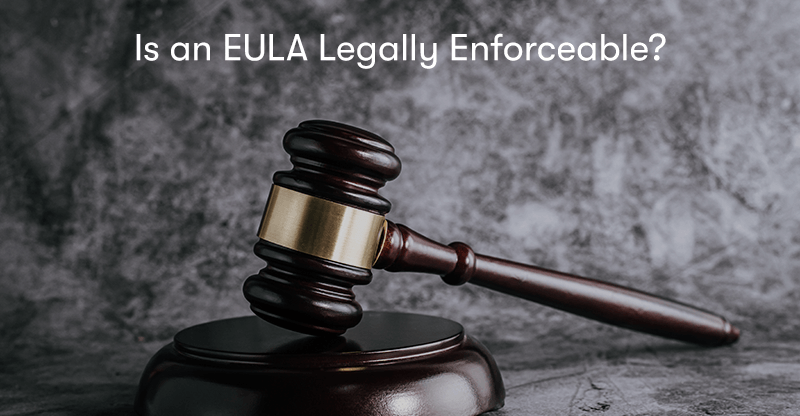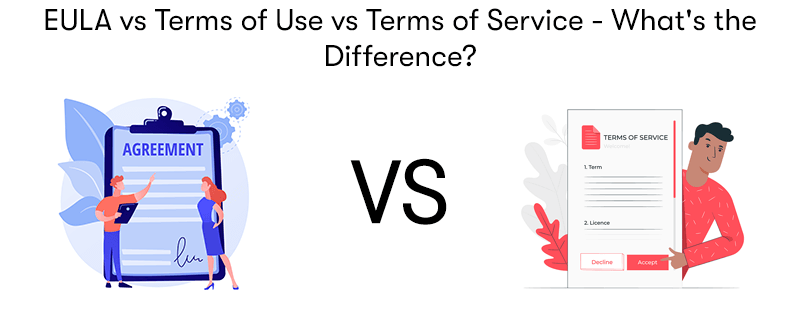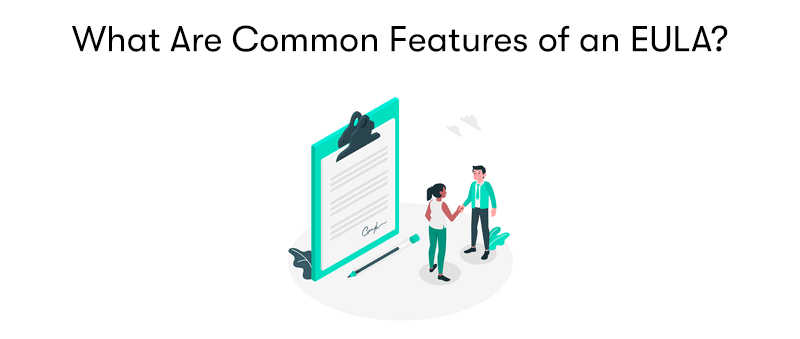What is an EULA (End-User License Agreement)?
Welcome to our insightful exploration of a crucial yet often overlooked aspect of software usage, the End-User License Agreement, commonly known as EULA. In today's digital age, where software is an integral part of our daily lives, understanding EULAs is more critical than ever.
These legal documents are not just fine print to be hastily clicked through. They are binding contracts that delineate the rights, restrictions, and responsibilities of the software provider and the user.
In this blog, we will uncover what EULAs are, their significance, and how they impact our interaction with software. Whether you're a casual user or an IT professional, this exploration will shed light on the legal frameworks that govern our digital tools.
What is an EULA (End-User License Agreement)?

EULA, or End-User License Agreement, is a legal contract between the developer or publisher of a software application and the user of that application. This agreement outlines the rights and restrictions pertaining to the use of the software. Here are some key aspects of a typical EULA:
License Grant
It usually grants users a non-exclusive, non-transferable license to install and use the software according to specific terms and conditions.
Restrictions
EULAs often detail restrictions on how the software can be used, including prohibitions on reverse engineering, decompiling, or modifying the software, as well as restrictions on sharing or redistributing the software.
Intellectual Property
This section asserts that the software is the publisher's intellectual property, and using the software does not transfer any ownership rights to the user.
Liability Limitations
EULAs often limit the software publisher's liability in cases where the software causes damage or loss, either directly or indirectly.
Warranty Disclaimers
They generally include disclaimers stating that the software is provided "as is" without any warranties, expressed or implied.
Termination
Details under what conditions the license to use the software may be terminated (e.g., if the user violates any terms of the agreement).
Usage Data and Privacy
Some EULAs include clauses about data collection and usage, especially relevant for internet software.
Jurisdiction
They often state which country's laws will govern the agreement.
Users need to read and understand an EULA before installing or using software, as accepting the agreement (often done by clicking "I agree" during the installation process) is legally binding.
Is an EULA Legally Enforceable?

The legal enforceability of an End-User License Agreement can vary depending on several factors, including the jurisdiction, the specific terms of the EULA, and how it is presented to and accepted by the user. Here are some key points to consider:
Jurisdictional Differences
The enforceability of EULAs can differ significantly from one country to another. Some jurisdictions may have laws or legal precedents that uphold most EULA terms, while others may view specific provisions as unenforceable.
Manner of Consent
How the user agrees to the EULA can impact its enforceability. Traditionally, EULAs are agreed to by a click-through process during software installation, where the user must click "I agree" to proceed. Courts have generally found such agreements to be binding, but the specifics can vary.
Clear and Reasonable Terms
For an EULA to be enforceable, its terms must be clear and reasonable. If the agreement contains overly complex language or hidden terms, a court may find it unenforceable.
Unconscionable or Illegal Terms
If an EULA contains terms that are considered unconscionable (extremely unfair) or illegal, those specific terms, or in some cases, the entire agreement, may be found unenforceable.
Notice and Opportunity to Review
Users must be given adequate notice of the terms and a reasonable opportunity to review them before being bound by them. If an EULA is presented in a way that users can easily overlook or not understand, its enforceability can be questioned.
Consumer Protection Laws
Consumer protection laws in some jurisdictions may limit the enforceability of certain types of EULA clauses, particularly those that waive consumer rights.
Public Policy Considerations
Sometimes, even if an EULA is technically legal and agreed upon, certain provisions may not be enforced if they are against public policy.
In practice, the enforceability of EULAs is a complex issue that can involve intricate legal analysis. Users should always read and understand an EULA before agreeing, and if necessary, seek legal advice, especially when dealing with software that plays a critical role in business or personal activities.
EULA vs Terms of Use vs Terms of Service - What's the Difference?

"EULA" (End-User License Agreement), "Terms of Use", and "Terms of Service" are all types of legal agreements, but they have different applications and focuses. Here's a breakdown of their differences:
EULA (End-User License Agreement)
Focus: Primarily used for software products.
Purpose: Grants the user a license to use a copy of the software. It doesn't sell the software but permits its use under certain conditions.
Contents: Details about how the software can be used, restrictions on copying or modifying the software, intellectual property rights, disclaimers, and limitations of liability.
Application: Typically encountered during the installation or first use of software.
Terms of Service (ToS)
Focus: Common for online services, including social media platforms, e-commerce sites, and web applications.
Purpose: Governs the relationship between the service provider and its users, outlining how users must behave, what is prohibited, and the conditions under which the service is provided.
Contents: Rules for using the service, account management policies, user responsibilities, service limitations, privacy policies, and termination of service.
Application: Often presented when a user signs up for an online service and must be agreed to before using the service.
Terms of Use (ToU)
Focus: Similar to Terms of Service, but more commonly associated with websites rather than specific services.
Purpose: Outlines the rules and guidelines for using a website and its content.
Contents: This may include acceptable use policies, copyright and content usage rules, disclaimers for liability, user conduct standards, and privacy policy.
Application: Typically found on websites, often in the footer, and may not always require explicit consent like a ToS or EULA.
In summary
An EULA is more specific to software use and licensing.
Terms of Service are broader, covering the terms under which a service is offered, including user obligations and service provider rights.
Terms of Use are often used for websites, outlining the terms under which a website and its content can be accessed and used.
While these terms are sometimes used interchangeably, and their contents can overlap, each serves a distinct purpose in the digital landscape. Users and providers need to understand the implications of each to ensure proper compliance and protection of rights.
License Agreements vs End-User License Agreements - What's the Difference?
License Agreements and End-User License Agreements (EULAs) are both types of legal contracts that deal with the use of software and intellectual property. Still, they serve slightly different purposes and contexts:
License Agreements
Broad Scope: This term can refer to any agreement that grants a license, which could be for various types of intellectual property, not just software. This includes things like music, images, patents, or proprietary technology.
Varied Parties: The parties involved in a license agreement can be businesses, individuals, or organisations, and it's not limited to just the end-user. For example, a business-to-business software license would fall under this category.
Flexible Terms: The terms and conditions in a license agreement can be highly variable, catering to the parties' specific needs. They can cover aspects like the duration of the license, geographic territories, exclusivity, and sublicensing rights.
Professional and Commercial Use: Often used in professional and commercial contexts, these agreements may involve negotiations and are tailored to specific use cases.
End-User License Agreements (EULAs)
Specific Focus: EULAs specifically deal with software and are directed towards the end-users of that software. They don't typically apply to other types of intellectual property.
Standardised Terms: EULAs are usually standardised and not subject to negotiation by the end-user. They're often presented as a click-through agreement during software installation.
Restrictions on Use: These agreements typically restrict how the software can be used, prohibiting reverse engineering, unauthorised sharing or copying, and software modification.
Consumer-Oriented: EULAs are designed for the consumer market and are meant to be understandable (to some extent) by the general public. They define the relationship between the software company (licensor) and the individual user (licensee).
In summary, while both agreements are centred around licensing, License Agreements are more general and can be applied in various contexts, often involving negotiations and tailored terms. EULAs, on the other hand, are specific to software and are typically standardised, focusing on the end-user's rights and restrictions regarding software use.
What Are Common Features of an EULA?

End-User License Agreements typically include several key features and clauses to outline the terms of software use and protect the rights of the software provider. Common features of an EULA include:
License Grant
Specifies the rights being granted to the user, such as the right to install and use the software.
Often defines the scope of the license, such as whether it is for personal or commercial use and any limitations on the number of installations.
Ownership and Intellectual Property Rights
Clarifies that the software is the licensor's property and that the license does not transfer ownership of the software to the user.
Includes information about copyright, trademarks, and other intellectual property rights.
Usage Restrictions
Details any limitations on how the software can be used.
Common restrictions include prohibitions on reverse engineering, modifying, copying, or redistributing the software.
Warranty and Disclaimer
States the extent of the warranties provided, if any.
Typically includes a disclaimer of warranties, indicating that the software is provided "as is" and may not be fault-free.
Limitation of Liability
Limits the licensor's liability in cases of software malfunction or other damages.
May specify the types of excluded damages, such as incidental or consequential damages.
Termination
Outlines the conditions under which the EULA and the license it grants can be terminated.
Usually includes a clause that allows the licensor to terminate the license if the user violates the agreement's terms.
Privacy Policy
If the software collects personal data, the EULA may include a privacy policy or a link to one.
Details how user data is collected, used, and protected.
Governing Law and Dispute Resolution
Specifies the jurisdiction under which the EULA is governed.
It may include terms about how disputes related to the agreement will be resolved.
Updates and Upgrades
May include terms about software updates and upgrades, including how they will be provided and whether they are covered under the EULA.
Export Controls
Contains clauses regarding compliance with international export control laws relevant to software that might be subject to such regulations.
User Acknowledgement
Typically, the EULA will require the user to acknowledge that they have read, understood, and agreed to the terms.
EULAs are legally binding contracts, and their specific terms can vary greatly depending on the software and the company providing it. Users are advised to read EULAs carefully before agreeing to them.
What Are Other Names for an End-User License Agreement?
An End-User License Agreement can be known by various other names, which generally refer to the same type of legal contract between a software provider and the user. These alternative names include:
| Term | Meaning |
| Software License Agreement | This term emphasises the licensing aspect of the agreement, specifically for software. |
| User Agreement | A more general term that indicates an agreement between the user and the provider, applicable to software and online services. |
| License Terms | This term highlights the licensing conditions for the software use. |
| Product License Agreement | Similar to the Software License Agreement, it can be used for both software and hardware products. |
| Subscriber Agreement | Commonly used for services that require a subscription, such as online platforms or software-as-a-service (SaaS) products. |
| Terms of Service (ToS) | Although typically broader and applicable to online services, in some contexts, Terms of Service can function similarly to an EULA, especially for software-based services. |
| Terms of Use (ToU) | Like ToS, it's a broader term that can sometimes encompass software licensing terms, particularly web-based applications. |
| Software Agreement | A general term that can encompass the EULA among other software-related agreements. |
| License User Agreement | A variation that emphasises the user's role in the agreement. |
| Software Usage Agreement | Focuses on the conditions related to the usage of the software. |
While these terms can often be used interchangeably, the specific name may depend on the context, the type of software or service, and the company's preference. Regardless of the name, users must read and understand these agreements as they set forth the legal terms and conditions for using the software or service.
What Are the Advantages of an EULA?
EULAs offer several advantages for both the software provider and the end user. Here are some of the key benefits:
Benefits For Software Providers
Protection of Intellectual Property: EULAs help safeguard the provider's intellectual property rights by clearly stating that the software is licensed, not sold, and restricting unauthorised copying, distribution, and modification.
Limitation of Liability: EULAs typically include clauses limiting the provider's liability in case of software malfunction or data loss, reducing potential legal risks.
Control Over Software Usage: By outlining specific terms and conditions, EULAs allow providers to control how their software is used, which can be essential for maintaining security, quality, and reputation.
Enforceable Terms and Conditions: A well-drafted EULA provides a legally enforceable framework that can be used to address violations, such as unauthorised distribution or misuse of the software.
Flexibility in Licensing Options: Providers can offer different licensing models (e.g., personal vs. commercial use) tailored to various user needs, opening diverse revenue streams.
Compliance and Regulatory Assurance: EULAs can ensure compliance with legal requirements and industry standards, which is particularly important for software dealing with sensitive data or operating in regulated sectors.
Benefits For End Users
Clear Usage Guidelines: EULAs provide users with clear guidelines on using the software, helping them avoid unintentional violations of the terms.
Understanding of Rights and Restrictions: Users are informed about their rights, such as the number of installations allowed, and any restrictions, such as prohibitions on resale or modification.
Transparency on Data Usage: For software that collects data, EULAs often include privacy policies, giving users a clear understanding of how their data will be used and protected.
Software Quality Assurance: By restricting piracy and unauthorised modifications, EULAs can help ensure that users receive a quality, secure, and stable product.
Awareness of Liability Limitations: Users are made aware of the extent of the provider's liability, helping set realistic expectations regarding support and compensation in case of software-related issues.
General Advantages
Standardisation: EULAs provide a standardised legal framework that users and providers can familiarise themselves with, simplifying the process of using and distributing software.
Facilitates Digital Commerce: By providing a legal structure for software licensing, EULAs enable the broader digital commerce ecosystem, supporting innovation and distribution in the software industry.
In summary, EULAs play a crucial role in the software industry by protecting the interests of both providers and users, ensuring clarity in the use of software, and upholding legal and regulatory standards.
How Do End-User License Agreements Relate to ITAM?
End-User License Agreements are closely related to IT Asset Management (ITAM), which manages and optimises an organisation's information technology (IT) assets, such as hardware, software, and services. The relationship between EULAs and ITAM is primarily centred around the management of software assets. Here's how they interconnect:
Compliance Management
License Compliance: ITAM ensures that all software used within an organisation is properly licensed. Understanding and adhering to the terms of EULAs is crucial to avoid legal issues like copyright infringement and to maintain compliance with software licensing agreements.
Audit Preparedness: Regular audits are a part of ITAM to ensure compliance with licensing agreements. EULAs often have audit clauses, and compliance with these agreements is essential during these audits.
Software Asset Optimisation
Cost Management: ITAM aims to optimise software costs. By understanding EULAs, ITAM professionals can ensure that an organisation only pays for the licenses it needs and uses, avoiding over-licensing or under-licensing.
License Utilisation: Understanding the terms of EULAs helps manage the number of licenses in use, ensuring that the organisation is within its permitted usage and is utilising its licenses efficiently.
Risk Management
Reducing Legal Risks: Non-compliance with EULAs can lead to legal actions from software vendors. ITAM helps mitigate this risk by ensuring adherence to these agreements.
Software Lifecycle Management: EULAs often have terms about the software lifecycle, including end-of-life policies. ITAM ensures that the organisation is prepared for software end-of-life scenarios, reducing risks related to security and functionality.
Strategic Planning
Future Licensing Needs: ITAM involves planning future IT needs, including software licensing. Understanding EULAs helps in making informed decisions about software purchases and renewals.
Negotiating Terms: In some cases, organisations can negotiate terms of EULAs with vendors. Effective ITAM can provide insights into the most beneficial and feasible terms for the organisation.
Documentation and Record Keeping
Maintaining License Records: ITAM involves keeping detailed records of all IT assets, including software licenses. This record-keeping is essential for managing EULAs effectively.
Proof of Licensing: In case of disputes or audits, ITAM provides the necessary documentation to prove that the organisation is compliant with its software EULAs.
In summary, EULAs are integral to IT Asset Management, particularly in managing software licenses. They provide the legal framework within which ITAM operates to ensure compliance, optimise costs, manage risks, and plan strategically for an organisation's software needs. Understanding and effectively managing EULAs is a critical component of successful ITAM.
Final Notes on End-User License Agreements
In conclusion, our exploration of End-User License Agreements has provided valuable insights into their legal enforceability, distinct characteristics compared to Terms of Use and Terms of Service, and their essential role within IT Asset Management.
We've dissected the typical features of EULAs, their advantages for software providers and users, and their various alternative names. This discussion highlights the importance of understanding EULAs not just as legal necessities but as pivotal tools in managing and optimising software assets within organisations.
As we navigate the complexities of software licensing and IT asset management, the knowledge of EULAs becomes indispensable for compliance, strategic planning, and risk mitigation.
We encourage readers to delve deeper into this topic to grasp its impact on the digital and business landscape fully.


